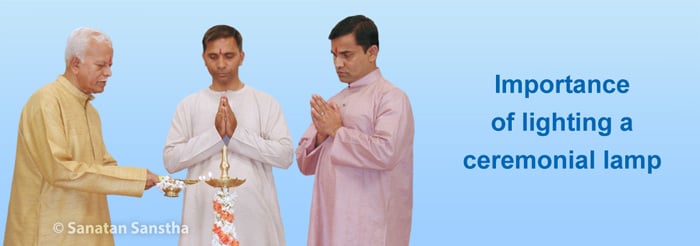
Hindu Dharma gives a lot of importance to a lamp. We would have come across many occasions where a ceremonious lamp has been lit. Even an average individual would feel a divine presence after lightening the lamp. Let us understand through this article how lighting of lamp purifies the environment as well as invites Divine waves to the premises.
1. Implied meaning of lighting a ceremonious lamp
A. Lighting a lamp amounts to awakening the atmajyoti (Glow of the soul) within oneself.
B. The serene aura around the lamp represents the atmaprakash (Light of the soul), while the Raja-predominant light of the lamp represents the atmatej (Radiance of the soul). Atmatej is symbolic of the activated sagun (Materialised)-shakti (Energy) of God, whereas atmaprakash symbolizes the functional Sankalp-shakti (Energy of resolve) of God behind the Tej (Absolute Fire Principle).
2. Importance of lighting a ceremonious lamp
A. Activation of the Sankalp-shakti of God
When any function is commenced by lighting of a lamp, with the help of atmajyoti, the respective Deity Principle is invoked from the Universe and a prayer is offered for the waves of the Deity to be present at the venue. This activates God’s Sankalp-shakti and the task is accomplished.
B. Creation of a protective sheath around the venue
Due to the movement of the Raja particles emitted by the flame of the lamp, the nirgun (Non-materialised) kriya-lahari (Waves of action) of God from the Universe get converted into Sagun Raja-predominant kriya-lahari and the strength of Kriya-shakti of God helps in the formation of a protective sheath of these kriya-lahari around the venue.
Thus, by lighting a lamp, in a way we purify the premises. Due to the circular radiant waves emanating from this protective sheath and having motion, superior level (more powerful) negative energies cannot enter the venue. Thus, the desired task is accomplished with Divine blessings and without any obstruction.
C. Protective covering (Subtle-effects) created while performing the ritual of lighting a lamp
A Spiritual Perspective
Thus, by lighting a lamp, in a way we purify the premises. Due to the circular radiant waves emanating from this protective sheath and having motion, superior level (more powerful) negative energies cannot enter the venue. Thus, the desired task is accomplished with Divine blessings and without any obstruction.
3. Spiritual science underlying lighting a ceremonious
lamp and breaking a coconut when inaugurating a programme on the stage
A. Breaking a coconut
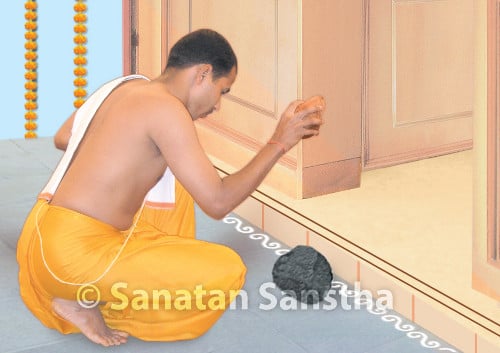
Breaking a coconut during inaugration
Before erecting a stage, when performing Bhumipujan (Worship of the earth), a coconut is broken to purify the area and to destroy the distressing vibrations. Where the stage is already set, a stone is placed in front of the stage, prayers are offered unto the Sthandevata (Deity of the place), followed by breaking of a coconut. When any programme is being arranged on the stage, purification of the premises is mandatory, else, negative energies can create obstacles in the programme, such as delay in commencement of the programme, a feeling of restlessness in the hall etc. When the Sthandevata is invoked with a prayer, His waves disperse in all directions through the medium of water in the coconut. This makes it possible to obstruct the speed of distressing vibrations arriving at the venue. Thus, the programme is completed without any obstacles. – A Scholar (Through the medium of Mrs Anjali Gadgil, 20.1.2005)
1. Positive vibrations: 4%’ – H.H. Dr Athavale
2. ‘Proportion of vibrations: Chaitanya (Divine consciousness) – 1%, Shakti – 3% and disintegration of distressing energy – 2%
3. Other points
A. Coconut has more capacity to attract all the three components namely Sattva , Raja and Tama . Therefore, it is used for puja (Ritualistic worship) as well as for removal of drushta (Casting off the evil-eye).
B. Purification of environment due to the vibrations of Chaitanya and Shakti emitted by the broken coconut and also the disintegration of negative vibrations in the premises attracted due to its capacity to attract all the components: While inaugurating, a coconut is hit on a stone and broken. At that time, the vibrations of Chaitanya and Shakti present in the coconut rapidly disperse into the environment and the environment is purified. At the same time, the negative vibrations present in the premises too get attracted to the coconut due to its power of attraction and they are disintegrated through its medium.
C. The sound created while breaking the coconut drives away the negative energies in the premises.
D. If an individual performs the action of breaking the coconut with bhav (spiritual emotion), he receives vibrations of Shakti.
E. Breaking a coconut during inauguration of a premise accomplishes both the actions, that is, emission of Sattva-predominant vibrations and disintegration of black energy. Similarly, a protective sheath is formed around the premises and Divine Principles are attracted to it.
– Ms Priyanka Lotlikar, Sanatan Sanstha (22.7.2010)
B. Lighting a ceremonious lamp
The stage is also called ‘the seat of knowledge’. Through the speaker on the stage, it is the God Principle that actually performs the service of imparting knowledge. The lit lamp symbolizes the atmajyoti, which is eternally knowledge bestowing. This flame burns perpetually to enlighten all individuals with the knowledge of Brahman (God in His aspect as the Creator of the universe), to ferry them across Maya (The Great Illusion). Lighting the lamp is in a way, an invocation of the waves of knowledge that are activated on stage. It also means keeping the waves of knowledge, generated on the knowledge imparting stage constantly active, through the medium of the flame of the lamp.
C. Lighting of the ceremonious lamp after breaking a coconut
Breaking of a coconut creates an obstruction in the movement of negative energies, and lighting of the ceremonious lamp signifies welcoming the Divine waves active on the Dnyanpeeth (Seat of knowledge) and appeasing them. Hence, first, the Sthandevata is invoked by breaking a coconut with a prayer to keep the negative energies in the premises under His control. Then, the ceremonious lamp is lit so that the waves emitted by the lamp restrict the movement of more powerful negative energies, and the mission of imparting of knowledge from the stage is accomplished.
D. After lighting the ceremonious lamp, breaking the coconut is not necessary
Divine waves emitted by a coconut are predominantly associated with the Pruthvi (Absolute Earth) and Apa (Absolute Water) tattvas (Principles). On the other hand, those emitted by a lit lamp are predominantly associated with the Tej-tattva. Thus, the coconut has the ability to repel less powerful negative energies (related to the Pruthvi and Apa tattvas), and the lit lamp has the ability to repel the more powerful negative energies (related to the Tej-tattva). Obviously, a coconut need not be broken after lighting a lamp on the stage.

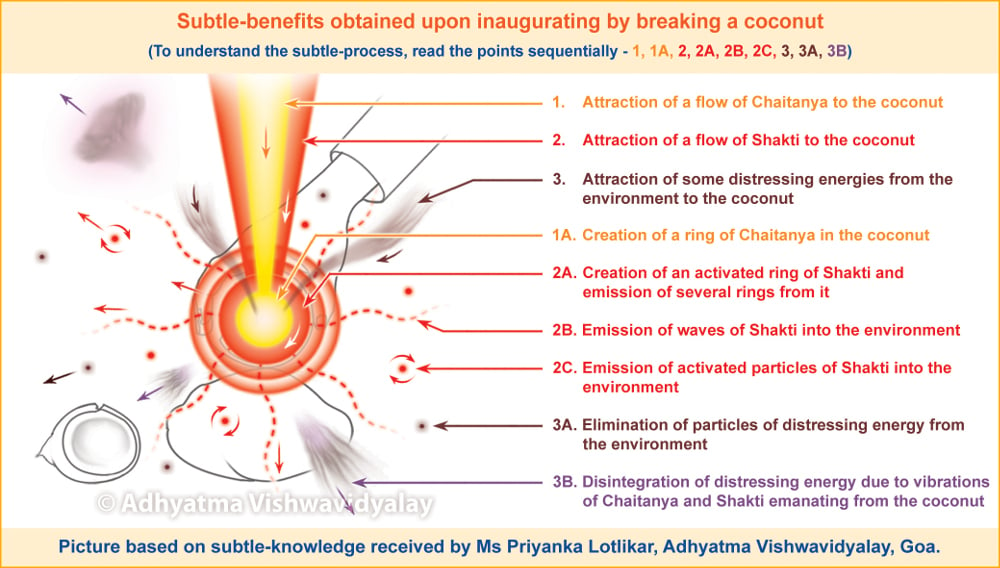
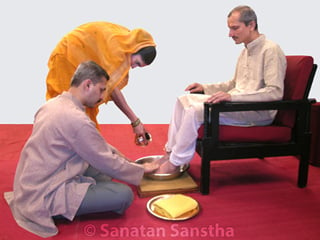 Do you know the correct way of doing Felicitation ?
Do you know the correct way of doing Felicitation ?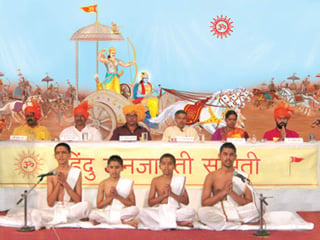 Why are Sanskrit Shlokas recited at functions?
Why are Sanskrit Shlokas recited at functions?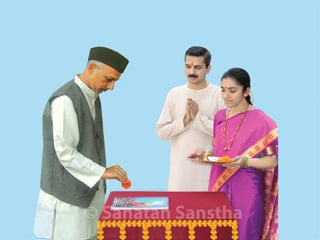 Book Release : How to do it Spiritually?
Book Release : How to do it Spiritually? Presenting a gift
Presenting a gift